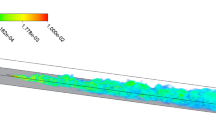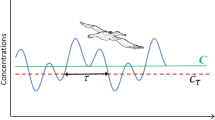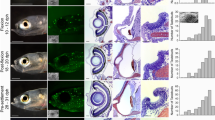Abstract
In natural habitats, animals encounter cues from multiple odor sources that may impact foragingDecisions. Previous work has focused on orientation behavior to one food odor source, and does not distinguish between mechanosensory and chemosensory guidance of orientation. The present study investigated how the spatial distribution of two food cues affects crayfish orientation behavior. Crayfish, Orconectes virilis, were presented with odor sources that were separated in an artificial stream. Orientation behavior was filmed from above and digitized at a rate of 1 frame per sec. Electrochemical recordings were taken to characterize the odor plume, and an acoustic doppler velocimeter was used to characterize the hydrodynamic structure of the artificial stream. Temporal changes in odor plume structure were seen as a result of the positioning of the odor sources. Changes in the intermittency of the odor pulses as well as concentration, rise time, and slope of the pulse were observed. Time series analysis showed that the lower frequency signals of the dual odor source were higher in energy than the single 1X or single 2X sources. Crayfish altered orientation strategies when presented with different spatial arrangements of food cues. In particular, the temporal aspects of the orientation pattern were most altered by the differences in odor presentations. Crayfish responded with faster walking speeds as a function of distance to the odor source and exhibited more consistent turning angles. This correlates with temporal changes in odor structure, and indicates that the temporal pattern of odor stimulation may be driving the temporal pattern of behavior.
Similar content being viewed by others
References
Atema, J. 1996. Eddy chemotaxis and odor landscapes: Exploration of nature with animal sensors. Biol. Bull. 191:129–138.
Bouwma, P. and Hazlett, B. A. 2001. Integration of multiple predator cues by the crayfish Orconectes propinqus. Anim. Behav. 61:771–776.
Finelli, C. M., Pentcheff, N. D., Zimmer-Faust, R. K., and Wethey, D. S. 1999. Odor transport in turbulent flows: Constraints on animal navigation. Limnol. Oceanogr. 44:1056–1071.
Finelli, C. M., Pentcheff, N. D., Zimmer, R. K., and Wethey, D. S. 2000. Physical constraints on ecological processes: A field test of odor-mediated foraging. Ecology 8:784–797.
Gomez, G. and Atema, J. 1996. Temporal resolution in olfaction: Stimulus integration time of lobster chemoreceptor cells. J. Exp. Biol. 199:1771–1779.
Gomez, G. and Atema, J. 1999. Temporal resolution in olfaction III: Flicker fusion and concentration-dependent synchronization with stimulus pulse trains of antennular chemoreceptor cells in the American lobster. J. Comp. Physiol. A 185:427–436.
Gomez, G., Voigt, R., and Atema, J. 1994. Frequency filter properties of lobster chemoreceptor cellsDetermined with high-resolution stimulus measurement. J. Comp. Physiol. A 174:803–811.
Hazlett, B. A. 1999. Response to multiple chemical cues by the crayfish Orconectes virilis. Behaviour 136:161–177.
Keller, T. A., Tomba, A. M., and Moore, P. A. 2001. Orientation in complex chemical landscapes: Spatial arrangement of chemical sources influences crayfish food-finding efficiency in artificial streams. Limnol. Oceanogr. 46:238–247.
Kozlowski, C., Voigt, R., and Moore, P. A. 2003. Effect of pulsed odor sources on the tracking behavior of crayfish (Orconectes rusticus). Mar. Fresh. Behav. Physiol. 36:97–110.
Kraus-Epley, K. E. and Moore, P. A. 2002. Bilateral and unilateral antennal lesions alter orientation abilities of the crayfish, Orconectes rusticus. Chem. Senses. 27:49–55.
Mafra-Neto, A. and Cardé, R. T. 1995. Influence of plume structure and pheromone concentration on upwind flight of Cadra cautella males. Physiol. Entomol. 20:117–133.
Mafra-Neto, A. and Cardé, R. T. 1996. Dissection of the pheromone-modulated flight of moths using single-pulse response as a template. Experientia 52:373–379.
McLeese, D. W. 1973. Orientation of lobsters (Homarus americanus) to odor. J. Fish. Res. Board. Can. 30:838–840.
Moore, P. A. and Atema, J. 1991. Spatial information in the three-dimensional fine structure of an aquatic odor plume. Biol. Bull. 181:408–418.
Moore, P. A. and Grills, J. L. 1999. Chemical orientation to food by the crayfish Orconectes rusticus: Influence of hydrodynamics. Anim. Behav. 58:953–963.
Moore, P. A., Grills, J. L., and Schneider, R. W. S. 2000. Habitat-specific signal structure for olfaction: An example from artificial streams. J. Chem. Ecol. 26:565–584.
Moore, P. A., Scholz, N., and Atema, J. 1991. Chemical orientation of lobsters, Homarus americanus, in turbulent odor plumes. J. Chem. Ecol. 17:1293–1307.
Moore, P. A., Weissburg, M. J., Parrish, J. M., Zimmer-Faust, R. K., and Gerhardt, G. A. 1994. Spatial distribution of odors in simulated benthic boundary layer flows. J. Chem. Ecol. 20:225–279.
Murlis, J. and Jones, C. D. 1981. Fine-scale structure of odor plumes in relation to insect orientation to distant pheromone and other attractant sources. Physiol. Entomol. 6:71–86.
Nowell, A. R. M. and Jumars, P. A. 1987. Flumes: Theoretical and experimental considerations for simulation of benthic environments. Oceanogr. Mar. Biol. Ann. Rev. 25:91–112.
Sanford, L. P. 1997. Turbulent mixing in experimental ecosystem studies. Mar. Ecol. Prog. Ser. 161:265–293.
Tomba, A. M., Keller, T. A., and Moore, P. A. 2001. Foraging in complex odor landscapes: Chemical orientation strategies during stimulation by conflicting chemical cues. J. North. Am. Benthol. Soc. 20:211–222.
Vickers, N. J. and Baker, T. C. 1992. Male Heliothis virescens maintain upwind flight in response to experimentally pulsed filaments of their sex pheromone (Ledpidoptera: Noctuidae). J. Insect Behav. 5:669–687.
Vickers, N. J. and Baker, T. C. 1994. Reiterative responses to single strands of odor promote sustained upwind flight and odor source location by moths. Proc. Natl. Acad. Sci. U.S.A. 91:5756–5760.
Weissburg, M. J., and Dusenbery, D. B. 2002. Behavioral observations and computer simulations of blue crab movement to a chemical source in a controlled turbulent flow. J. Exp. Biol. 205:3387–3398.
Weissburg, M. J. and Zimmer-Faust, R. K. 1993. Life andDeath in moving fluids: Hydrodynamic effects on chemosensory-mediated predation. Ecology 74:1428–1443.
Weissburg, M. J. and Zimmer-Faust, R. K. 1994. Odor plumes and how blue crabs use them in finding prey. J. Exp. Biol. 197:349–375.
Westerberg, H. 1991. Properties of aquatic odor trails, pp. 45–54, in K. B. Døving (ed.). Proceedings of the Tenth International Symposium on Olfaction and Taste. Graphic Communication System, Oslo.
Zimmer, R. K., Commins, J. E., and Browne, K. A. 1999. Regulatory effects of environmental chemical signals on search behavior and foraging success. Ecology 80:1432–1446.
Zimmer-Faust, R. K., Finelli, C. M., Pentcheff, N. D., and Wethey, D. S. 1995. Odor plumes and animal navigation in turbulent water flow: A field study. Biol. Bull. 188:111–116.
Author information
Authors and Affiliations
Corresponding author
Rights and permissions
About this article
Cite this article
Wolf, M.C., Voigt, R. & Moore, P.A. Spatial Arrangement of Odor Sources Modifies the Temporal Aspects of Crayfish Search Strategies. J Chem Ecol 30, 501–517 (2004). https://doi.org/10.1023/B:JOEC.0000018625.83906.95
Issue Date:
DOI: https://doi.org/10.1023/B:JOEC.0000018625.83906.95




